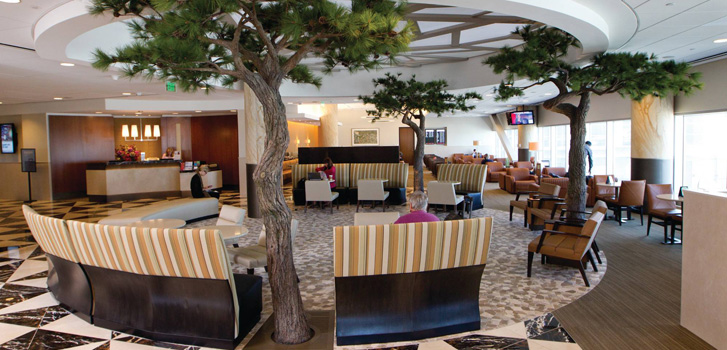The Flight Deal team didn’t get hooked on the value of miles and the concept of elite status until a trip to Las Vegas in the late ’90s. Then, we were road warriors (e.g., flying out Monday morning and coming home Thursday night – all domestic flights); now, we’re flying 8 to 12 times a year – purely international. After about 3 months of the grind, we made Silver status (the lowest of the low) and we didn’t really know what that meant.
That changed with the trip to Las Vegas. We flew JFK – Los Angeles – Las Vegas – Portland – JFK because that was the cheapest fare available and luckily for us, it was on the airline which we had Silver status on. On the outbound, we weren’t upgraded. But coming back, we were upgraded from Las Vegas to Portland to JFK. The upgrade from Las Vegas to Portland wasn’t that impressive because it was basically an upgraded coach seat with booze and 6 inches more legroom. But when we boarded Portland to JFK, we were treated to an international configured business class seat that almost lied flat. This was in the ’90s, and it was amazing!
From that flight on, we were hooked. The team here has collectively flown over 2 million miles since then and have probably only sat in coach about 10% of those miles. So how exactly do you get an upgrade? How do you get out of coach? The short answer: get elite status with an airline, use miles, operational upgrades or buy the seat. Let’s dissect each way.
Elite Status
Elite Status is benefit usually granted to flyers after they fly over 25,000 miles. The higher the status, the better the benefits. Here are some of the common benefits of elite status:
- Access to business and first class lounges with an economy ticket
- Access to other airlines’ lounges
- Increased mileage accumulation (such as doubling or tripling)
- Reserving an unoccupied adjacent seat
- The ability to reserve specific seats, such as exit row seats with more leg room
- Free or discounted upgrades to a higher travel class (Emphasis ours)
- Priority in waitlisting or flying standby
- Preference in not being bumped if a flight is oversold
- Priority of luggage (to be prioritized on transfer and to be displayed on the belt first)
- Waived or reduced fees (e.g. baggage fees, service charges)
In general, airlines will upgrade their elite members first. Elite status members will fill up most domestic cabins since upgrades for all major airlines in the US are free with the exception of American Airlines’ lower tier members. These upgrades are generally processed 24 hours to 168 hours out. International upgrades usually require very valuable Systemwide Upgrade certificates offered only to the programs highest elite members. The other way to upgrade international flight is with the usage of miles.
Mileage Upgrades
Airlines offer mileage upgrades where members redeem miles for upgrades. The mileage required can be anywhere from 5,000 to 35,000 miles plus often a co-pay fee depending on the distance. Mileage upgrades for international flights are generally not worth it. Most airlines currently require $250 + 25,000 miles to upgrade each way; to upgrade roundtrip, it will require $500 + 50,000. From a value perspective, assuming the 50,000 miles are worth a penny a piece, that’s $500. So the total cost of the coach ticket for an international flight can range from $800 to $1,200, plus another $1,000. A better option would be for you to call the airline and ask for a discounted business class seat. Discounted business class seats require 50 days advance purchase and are not flexible and usually aren’t that much more than a standard full fare coach ticket. So if your plans are fixed, consider that before buying a coach ticket and using miles to upgrade.
Operational Upgrades
The urban myth of upgrades of wearing a suit so you can get an upgrade probably comes from an operational upgrade. The same is true when you’re going on an honeymoon, etc. We aren’t saying that it’s never happened, but it’s a statistical outlier/anomaly. It’s equivalent to trying to win the lottery.
An operational upgrade happens when there is an oversell situation in coach and coach passengers are moved to Business or First Class. Airlines often oversell their coach cabin because there are a certain percentage of passengers who don’t show up. But when they do, airlines have to do one of two things: find volunteers for denied boarding which results in airline credit or transportation voucher for the passenger; if there aren’t enough volunteers, the airlines will perform an involuntary denied boarding which is bad for them when it comes to published statistics.
The standard operating procedure for airlines is to perform operational upgrades for their elite members first, then their alliance’s elite member and finally, they will randomly choose a customer, which is usually based on customer’s check-in time. Now these procedures are audited because for check-in agents or gate agents to give out operational upgrades out of standard operating procedure would only cause them trouble.
Has wearing a suit resulted in an operational upgrade? Likely, but probably not because the passenger was wearing a suit but more likely because in addition to the suit, they had elite status or had an early check-in time.
To consistently get an upgrade, stay loyal to one airline, collect miles, receive status with them and then you will sit in first class consistently on a coach ticket. Anyone who tells you otherwise hasn’t been an elite member, got comped an upgrade because they work in the media/industry or is lying to you.
=====
To make sure you receive our latest deals, LIKE our The Flight Deal Facebook Page, follow us on Twitter @TheFlightDeal, or subscribe to The Flight Deal RSS Feed.



